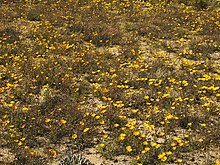Dimorphotheca
From Wikipedia, the free encyclopedia
| Dimorphotheca | |
|---|---|
 | |
| Dimorphotheca sinuata | |
| Scientific classification | |
| Kingdom: | Plantae |
| (unranked): | Angiosperms |
| (unranked): | Eudicots |
| (unranked): | Asterids |
| Order: | Asterales |
| Family: | Asteraceae |
| Tribe: | Calenduleae |
| Genus: | Dimorphotheca Vaill. ex Moench. |
| Synonyms[1] | |
| |
Dimorphotheca is a genus of plants in the sunflower family, native to Africa and Australia.[2] is one of eight genera of the Calenduleae, with a centre of diversity in Southern Africa. Some species can hybridize withOsteospermum, and crosses are sold as cultivated ornamentals. The name "Dimorphotheca" comes from the Greek "Dis" "Morphe" and "Theka", meaning "two shaped fruit", referring to the dimorphic cypselae, a trait inherent to members of the Calenduleae.[3] Plants of this genus usually have bisexual flowers.
- Species[1]
- Dimorphotheca acutifolia
- Dimorphotheca barberae
- Dimorphotheca caulescens
- Dimorphotheca chrysanthemifolia
- Dimorphotheca cuneata
- Dimorphotheca dregei
- Dimorphotheca fruticosa
- Dimorphotheca jucunda
- Dimorphotheca montana
- Dimorphotheca nudicaulis
- Dimorphotheca pluvialis ("Ox-Eye daisy", "Cape Daisy", "Rain Daisy")
- Dimorphotheca polyptera
- Dimorphotheca pulvinalis
- Dimorphotheca sinuata ("Cape Marigold", "African Daisy", "Star of the Veldt")
- Dimorphotheca spectabilis
- Dimorphotheca tragus
- Dimorphotheca turicensis
- Dimorphotheca venusta
- Dimorphotheca walliana
- Dimorphotheca zeyheri




ليست هناك تعليقات:
إرسال تعليق